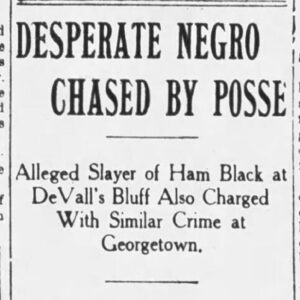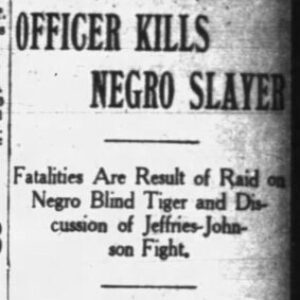calsfoundation@cals.org
St. Francis County Reported Lynching of 1910
A reported 1910 lynching in St. Francis County illustrates the difficulty of doing research in this field. While historian Richard Buckelew included the incident in the list of Arkansas lynchings he compiled for his 1999 dissertation, it seems that the violence was inflicted by a posse. There is a blurred line between lynch mobs and posses, as in many cases posses killed fleeing African Americans rather than jailing them and letting them face trial. In this particular case, the shooting was particularly egregious, as the suspect killed may not have been the alleged murderer.
According to the Arkansas Gazette, the incident stemmed from a disagreement between whites and African Americans near Georgetown (White County) at the new bridge for the Missouri and North Arkansas Railroad. The trouble began when authorities raided a “blind tiger” (a place that illegally sells liquor). An African American was operating the establishment and had been turned in to authorities. The Gazette offers conflicting stories about the altercation that occurred in early July, sometime after the blind tiger had been closed. The first was that the conflict was brought to a head in a heated discussion of the recent boxing match between Jack Johnson and James Jeffries. At the end of this match, followed around the country, Johnson (who was Black) was declared the winner over Jeffries (who was white). The second story holds that a white bridge tender named Frank Johnson had reported the African American running the blind tiger to the authorities and the proprietor decided to retaliate. Johnson was shot and killed, and the alleged perpetrator, accompanied by some friends, fled with his rifle.
Johnson’s body was taken to town and the authorities were notified. A posse set out through the swamplands, and, after a short pursuit with a hand car, they spotted some of the alleged fugitives. When they refused to stop, the posse fired buckshot at them. One was reportedly fatally wounded and was carried off into the woods. The posse wounded another Black man, who stopped and was captured. He was taken back to Georgetown, where it was determined that he had not been involved in the original altercation.
In the meantime, the posse continued its pursuit of the others, and on the afternoon of July 5, the posse encountered them on the railroad tracks two miles south of Wheatley (St. Francis County). One of the fugitives was carrying a rifle, and when the posse ordered him to halt, he raised it. A deputy shot and killed him, and the others fled. According to the Gazette, the Black man killed near Wheatley was later identified as the man who shot Johnson. On July 29, 1910, the Gazette published an account of one Sonny Brown, who had allegedly killed Ham Black, “a negro restaurant keeper” of DeValls Bluff (Prairie County), and who was being pursued by a posse in the area between Brinkley (Monroe County), Helena (Phillips County), and Memphis, Tennessee. Brown was named as having been connected with the killing of Johnson in Georgetown.
Buckelew placed this supposed lynching, which he set in White County, on his list based on a July 6 article in the Atlanta Constitution. This article, datelined from Little Rock (Pulaski County) late on July 5, was based on a report that evening from Georgetown. The particulars of the case were significantly different. According to this report, on July 5, an African American railroad employee had killed a Georgetown hotel proprietor named A. F. Johnson. They had apparently engaged in “a trivial dispute,” and the Black man, allegedly inebriated, had shot Johnson. According to the Constitution, the posse pursuing Johnson’s alleged murderer killed a Black man, who turned out not to be the perpetrator, and was still searching for the guilty party.
Such confusion frequently emerges when doing research on lynching. The names, locations, and dates frequently differ depending upon what reports are consulted, and individual researchers interpret them in different ways.
For additional information:
“Desperate Negro Chased by Posse.” Arkansas Gazette, July 29, 1910, p. 2.
“Officer Kills Negro Slayer.” Arkansas Gazette, July 6, 1910, p. 1.
“Wrong Negro Killed by Arkansas Posse.” Atlanta Constitution, July 6, 1910, p. 1.
Nancy Snell Griffith
Davidson, North Carolina
 Civil Rights and Social Change
Civil Rights and Social Change Early Twentieth Century, 1901 through 1940
Early Twentieth Century, 1901 through 1940 Law
Law St. Francis County Reported Lynching of 1910 Article
St. Francis County Reported Lynching of 1910 Article  St. Francis County Reported Lynching of 1910 Article
St. Francis County Reported Lynching of 1910 Article 




Comments
No comments on this entry yet.